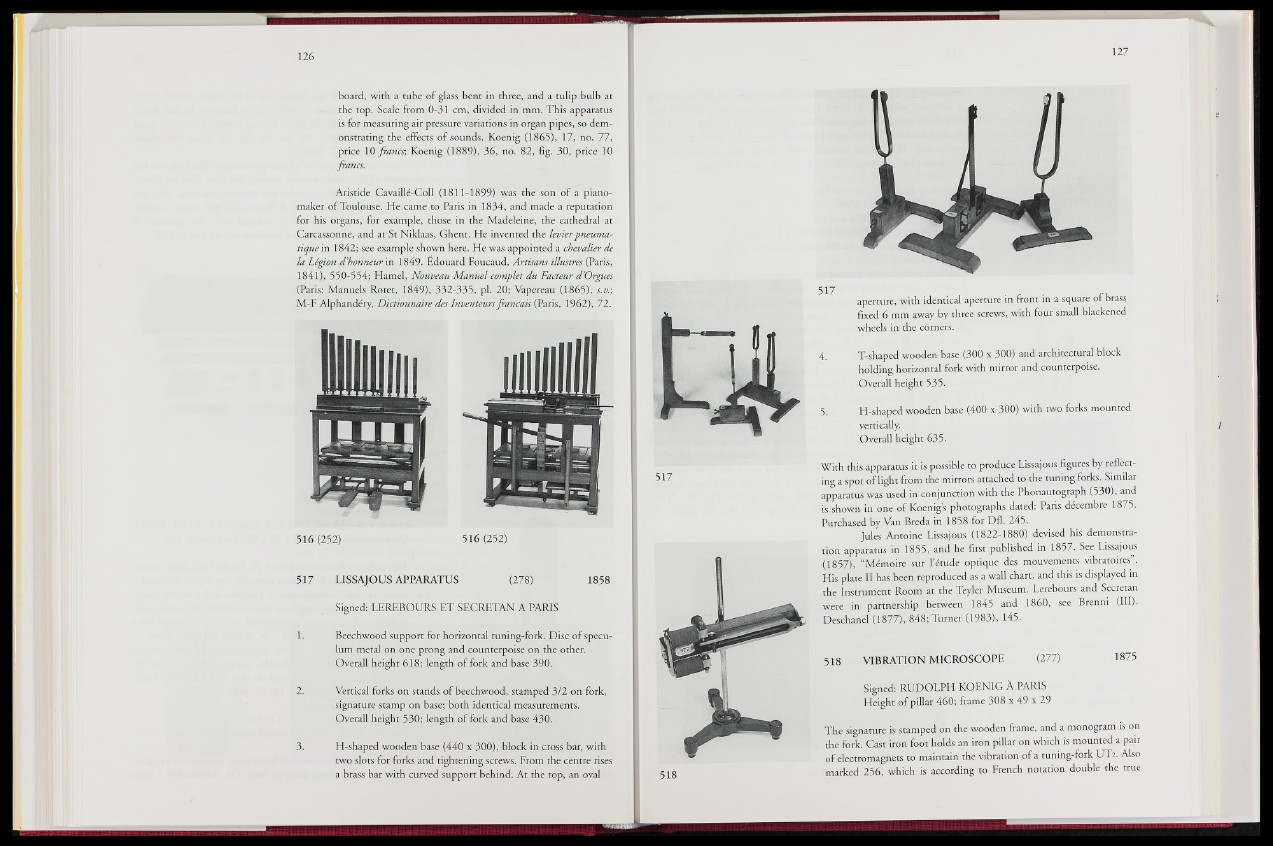
board, with a tube of glass bent in three, and a tulip bulb at
the top. Scale from 0-31 cm, divided in mm. This apparatus
is for measuring air pressure variations in organ pipes, so demonstrating
the effects of sounds. Koenig (1865), 17, no. 77,
price 10 francs\ Koenig (1889), 36, no. 82, fig. 30, price 10
francs.
Aristide Cavaillé-Coll (1811-1899) was the son of a piano-
maker of Toulouse. He came to Paris in 1834, and made a reputation
for his organs, for example, those in the Madeleine, the cathedral at
Carcassonne, and at St Niklaas, Ghent. He invented the levier pneumatique
in 1842; see example shown here. He was appointed a chevalier de
la Légion d ’honneur va 1849. Edouard Foucaud, Artisans illustres (Paris,
1841), 550-554; Hamel, Nouveau Manuel complet du Facteur d ’Orgues
(Paris: Manuels Roret, 1849), 332-335, pl. 20; Vapereau (1865), s.v.;
M-F Alphandéry, Dictionnaire des Inventeurs français (Paris, 1962), 72.
516 (252) 516 (252)
517 LISSAJOUS APPARATUS (278) 1858
Signed: LEREBOURS ET SECRETAN A PARIS
1. Beechwood support for horizontal tuning-fork. Disc of speculum
metal on one prong and counterpoise on the other.
Overall height 618; length of fork and base 390.
2. Vertical forks on stands of beechwood, stamped 3/2 on fork,
signature stamp on base; both identical measurements.
Overall height 530; length of fork and base 430.
3. H-shaped wooden base (440 x 300), block in cross bar, with
two slots for forks and tightening screws. From the centre rises
a brass bar with curved support behind. At the top, an oval
aperture, with identical apertùre in front in a square of brass li l i H
fixed 6 mm away by three screws, with four small blackened
wheels in the corners.
4. T-shaped wooden base (300 x 300) and architectural block
holding horizontal fork with mirror and counterpoise.
Overall height 535.
5. H-shaped wooden base (400 x 300) with two forks mounted
vertically^ 4; 1
Overall height 635.
With this apparatus it is possible to produce Lissajous figures by reflecting
a spot of light from the mirrors attached to the tuning forks. Similar
apparatus was used in conjunction with the Phonautograph (530), and
is shown in one of Koenig’s photographs dated: Paris decembre 1875.
Purchased by Van Breda in 1858 for Dfl. 245.
Jules Antoine Lissajous (1822-1880) devised his demonstration
apparatus in 1855, and he first published in 1857. See Lissajous
(1 8 f?S|“Mémoire sur l’étude optique des mouvements vibratoires’ .
His plate II has been reproduced as a wall chart, and this is displayed in
the Instrument Room at the Teyler Museum. Lerebours and Secretan
were in partnership between 1845 and 1860, see Brenni (III).
Deschanel (1877), 848; Turner (1983), 143,
518 VIBRATION MICROSCOPE (2f§)k 1875
Signed: RUDOLPH KOENIG A PARIS
Height of pillar 460; frame 308 x 49 x 29
The signature is stamped on the wooden frame, and a monogram is on
the fork. Cast iron foot holds an iron pillar on which is mounted a pair
of electromagnets to maintain the vibration of a tuning-fork UT2. Also
marked 256, which is according to French notation double the true